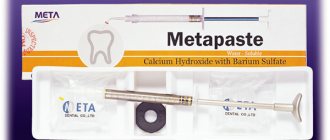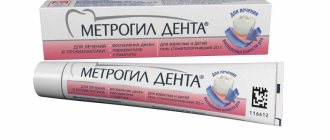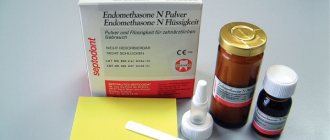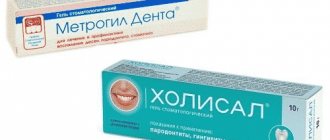4147
Pulpitis is diagnosed in a third of all patients who visit dentists. Most often, its treatment ends with pulpectomy - complete removal of the pulp and obturation of the canals.
The biological (vital) method of treatment (pulpotomy) is used much less frequently. Although, based on its merits, it deserves much more attention from dentists.
Composition and release form
The product is available in powder and liquid form, 30 g and 15 ml, respectively. The substances included in Pulpotec promote the effective treatment of temporary and permanent molars, aseptic healing of the internal soft tissues of the tooth with maximum preservation of its root structure.
The effect of the drug makes it possible to minimize the risk of complications characteristic of total pulpotomy.
The main active ingredients of the powder part of the drug:
- Zinc oxide (concentration up to 100%).
- Iodoform.
- Polyoxymethylene.
The liquid contains the following substances:
- Formaldehyde.
- Phenol.
- Dexamethasone acetate.
- Guaiacol.
- Auxiliary components.
General concept of drug effects
Pulpotec is used for diseases of the pulp of both temporary and permanent molars. When using the medicine, the following happens:
- the pulp of the inflamed crown is removed;
- the bleeding stops (press cotton balls for a few minutes);
- the drug is introduced into the pulp chamber;
- the dental cavity is temporarily filled;
- after 8-10 days, temporary cement and remaining medication are removed;
- a denser ball of medication is introduced into the tooth cavity;
- install a permanent filling.
The effectiveness of the medicine is time-tested. After its use, pain disappears in 80-85% of cases.
Indications and contraindications for use
Pulpotek is used for:
- carrying out vital pulpotomy of permanent teeth in adult patients, including those cases when subsequent prosthetics are necessary (installation of a crown or bridge);
- pulpitis of vital non-permanent teeth in children;
- treatment of calcified root canals in elderly patients;
- restoration of molars whose roots have not yet fully formed;
- treatment of infected non-permanent molars by pulpectomy, including in the presence of inflammation (in this case, the medication is not administered into the canals of temporary teeth in children).
The drug has found wide application in pediatric dental practice.
The drug is not recommended for use in the following cases:
- the patient exhibits hypersensitivity to the components of the drug;
- the patient suffers from chronic diseases (diabetes, kidney inflammation, leukemia, etc.)
- with diffuse type pulpitis.
Medical Internet conferences
For many years, formocresol was considered the “gold standard” in the treatment of pulpitis of primary teeth using the vital amputation method. However, in recent years, most researchers have recommended abandoning the use of this drug due to its potential toxicity to tooth tissue and the child’s body as a whole in favor of more biocompatible drugs, such as ferrous sulfate and mineral trioxide aggregate (MTA).
Purpose of the study: to evaluate the immediate clinical and radiological results of treatment of pulpitis of primary teeth in children using the method of vital amputation using ferrous sulfate, MTA and the drug "Pulpotek".
Materials and methods: pulp therapy was carried out in 97 children aged 3 to 7 years. Vital pulpotomy was used to treat 120 temporary molars with a diagnosis of chronic fibrous pulpitis using ViscoStat (Ultradent, USA), Pulpotek (PD, Switzerland) and Trioxident (Vladmiva, Russia). Treatment was carried out under infiltration anesthesia in one visit.
Follow-up examinations after treatment were carried out after a week, a month and then every three months. Before treatment, as well as 6 and 12 months after treatment, targeted intraoral radiographs were taken. The outcome was considered favorable if the patient had no complaints, clinical signs of pulp inflammation and pathological changes on the radiograph.
Results: the average age of the children at the time of treatment was 5.9±0.6 years. When patients were re-examined after 1, 3, 6, 9 and 12 months, there were no complaints of pain. During the observation period, clinical examination revealed a change in the color of the crowns of 5 (8%) temporary molars of the first group. Percussion of the teeth and palpation of the transitional fold in the projection of the roots were painless, there were no inflammatory phenomena from the oral mucosa. Assessment of the condition of the fillings showed good marginal fit, absence of secondary caries, marginal staining, cracks and pores on the surface of the restorations.
X-ray examination revealed rarefaction of bone tissue with unclear contours in the area of root furcation in 1 (3%) temporary molar of the third group. In other cases, X-ray diagnostics showed positive dynamics: the absence of internal and/or external root resorption, as well as the absence of destruction of the cortical plate and bone tissue in the periapical region.
Conclusions: the immediate results of the use of the drugs “ViscoStat”, “Trioxident” and “Pulpotek” in the treatment of pulpitis of primary teeth using the method of vital amputation showed high clinical effectiveness and allow us to recommend them for wider use in the practice of pediatric dentists.
Methods of use
Partial devitalization of the pulp with the help of Pulpotec is in many ways similar to the complete devitalization of teeth, carried out with arsenic and paraformaldehyde preparations:
- Local anesthesia is administered in a manner determined by the clinical situation.
- The carious cavity is prepared using a diamond drill of the required size and shape. It is advisable to immediately prepare the crown part of the tooth for subsequent restoration.
- The pulpous chamber is opened and processed. The inflamed portion of the pulp is removed using a high-speed bur and/or laser. Access to root canals is provided.
- Antiseptic treatment of the tooth cavity is carried out with chlorhexidine, sodium hypochloride, dimexide or other antiseptic.
It is advisable to repeat the treatment 2-3 times. If there is no bleeding (a small amount of blood is acceptable), the pulp chamber is dried with an air stream. - Pulpotec is introduced into the tooth cavity. This can be done in two ways – standard and alternative; their differences are described below.
- A temporary filling is applied. A break of about 7 hours is taken to allow the paste to harden.
At the next visit, the tooth is filled and restored with permanent material. It can be applied on top of Pulpotec or on a layer of temporary cement.
For children
Treatment of pulpitis of temporary and permanent molars. In the first case, the use of the drug allows you to stop the inflammatory process in the dental pulp, remove pain and wait for the natural replacement of milk teeth with permanent elements of the jaw row.
When treating permanent molars, it is possible to complete the formation of dental roots.
For adults
- Treatment of pulpitis of permanent molars.
- Preparation of lateral chewing teeth for the installation of bridges and crowns.
- Treatment of teeth with obliterated, difficult to pass canals.
Contraindications:
- Hypersensitivity to the components of the product.
- Serious systemic diseases (leukemia, renal failure, diabetes, etc.).
- Diffuse pulpitis (spread of inflammation to the entire pulp, not only the coronal, but also the root).
- Resorption of more than half of the tooth root.
Standard
With the classic method, the doctor mixes the powdered component of the drug with liquid until a homogeneous paste without inclusions is obtained, and places a small ball of the drug inside the chamber.
If a small amount of blood is released during the process, it does not affect the effectiveness of the effect. The oral cavity itself is first dried, and after applying the material, a temporary filling is placed on the tooth.
To ensure that the drug adheres securely to the mouth of the canal and its walls, the doctor places a cotton wool roll between the patient’s teeth. When he bites it, the paste comes into close contact with the walls of the cavity, as a result of which the most effective treatment is ensured.
Alternative
The dentist may also apply the composition in another way. The product is mixed to a homogeneous consistency on a laboratory glass slide, then a ball is formed from the resulting medium-hard paste and placed in a chamber.
Then the product is pressed mechanically to ensure contact with all surfaces of the internal cavity, and a temporary filling is placed.
Polymerization requires about 7 hours; during the second visit to the doctor, the specialist uses dental cement to install a permanent filling. It can be performed directly on the drug bead.
Some specialists leave a small layer of temporary cement to isolate the main filling from Pulpotek.
Note:
Teeth treated with Pulpotec and covered with non-removable orthopedic structures (crowns or bridges) may show pain after several months (from 3 to 1 year), despite the absence of radiological signs of damage. They usually disappear after correction of the bite height.
To successfully perform a pulpotomy procedure with Pulpotec:
- Pulpotomy is a simple operation, but it must be performed flawlessly: the cutting must be done clearly and quickly to avoid rupture of the root pulp endings and isolation of the entire intracavitary pulp.
- the treatment applies only to vital molars (study all the indications in the annotation and be guided only by them).
- The seal isolating Pulpotec must be made absolutely hermetically to avoid leakage of the drug.
Warning:
Do not use Pulpotec during pulp extraction. Avoid contact of the material with soft tissues. In case of contact, rinse thoroughly with running water. Contains formaldehyde and polyoxymethylene. Toxic if inhaled and swallowed. May cause irritation, burning or hypersensitivity upon direct contact with skin. In case of contact with eyes, rinse with running water and consult a doctor.
Storage : Store at a temperature of 5-30 ◦C, avoid direct light.
Made in Switzerland.
Packaging : in 2 bottles: 15 g of powder and 15 ml of liquid.
Price: $65.
Analogues: Formocresol, Pulpodent.
Indications and contraindications
Pulpotec is intended primarily for the treatment of posterior posterior teeth.
For children
Treatment of pulpitis of temporary and permanent molars. In the first case, the use of the drug allows you to stop the inflammatory process in the dental pulp, remove pain and wait for the natural replacement of milk teeth with permanent elements of the jaw row.
When treating permanent molars, it is possible to complete the formation of dental roots.
For adults
- Treatment of pulpitis of permanent molars.
- Preparation of lateral chewing teeth for the installation of bridges and crowns.
- Treatment of teeth with obliterated, difficult to pass canals.
Contraindications:
- Hypersensitivity to the components of the product.
- Serious systemic diseases (leukemia, renal failure, diabetes, etc.).
- Diffuse pulpitis (spread of inflammation to the entire pulp, not only the coronal, but also the root).
- Resorption of more than half of the tooth root.
STORAGE CONDITIONS
Store in a dry place, protected from direct sunlight, in a tightly closed container, at a temperature from +5°C to +25°C.
Shelf life – 3 years.
Failure to comply with storage conditions leads to changes in the performance characteristics of the material and a reduction in its shelf life.
The manufacturer is not responsible for loss of product quality caused by non-compliance with the conditions of transportation, storage and use established by the manufacturer for these products.
Responsibility for using the material for purposes other than those specified by the manufacturer rests with the user.
Side effects
The medicine is well tolerated by patients. Often the drug does not cause pain, however, in some cases the following undesirable reactions may occur:
- mild pain, which, as a rule, goes away after a subsequent visit to the dentist (pain relief is carried out by introducing a new portion of material after removing the primary and installing a temporary filling);
- periodic arthritic pain that goes away after the inflammation is relieved with medications;
- acute pain is extremely rare (1:1000), the cause of sharp pain may be the treatment of a non-viable molar, or failure to detect a perforation of the cavity wall or a fracture of the dental crown (in this situation, temporary material is removed, a diagnosis is made and treatment is performed with a pulpectomy or the tooth is removed) .
Modern treatment of pulpitis without the use of arsenic
Patient K. came to the clinic with complaints of severe pain in the gums in the area of the 47th tooth. The tooth was treated 3 days ago in the self-supporting department of the district clinic for chronic pulpitis.
| PHOTO 1: Visible devitalizing material at the mouth of the root canal and necrotic gums between the teeth against the background of inflamed soft tissues. | PHOTO 2: On the day of contacting our clinic, the canals were processed and sealed, the gums were treated, and a sealed temporary filling was placed (see x-ray). |
| PHOTO 3: Photo after 1 week: inflammation of the gums and soft tissues has been eliminated. | PHOTO 4: a month later, the tooth was completely restored with a ceramic inlay. |
For reference: Treatment methods for pulpitis differ in the method of anesthetizing the pulp. If devitalizing pastes (paraformaldehyde, paste with arsenic, etc.) are used to “kill the nerve,” then the methods are called devitalizing. And if the treatment takes place under anesthesia and without the use of drugs that kill the pulp, then such methods are called vital.
Everyone knows that arsenic is a poison. But it can be used for peaceful purposes. And the older generation probably remembers that arsenic was previously used by dentists to “kill the nerve.” At the same time, with arsenic in the tooth, it was under no circumstances possible to “walk” for more than the appointed time. Why was it used?
To treat pulpitis (inflammation of the “nerve”), the dental pulp must be removed and the cleaned canals of the tooth must be sealed. Since previously anesthetics were not “strong” enough, and the instruments for working in the canals were not thin and flexible enough, the dentist used arsenic to be on the safe side, so that there would be no pain in the tooth during or after the manipulation.
And even then the terms “arsenic periodontitis” and “arsenic periodontitis” arose, and scary pictures appeared in dental textbooks illustrating complications caused by the use of arsenic, such as osteomyelitis and mediastenitis. Every dental office even had an antidote - unithiol in case of an overdose of the drug.
It would seem that everything is in the past. But the incident with which I began the story happened the other day. The photograph (PHOTO 1) shows a “dead” gum.
In order to treat chronic pulpitis, the dentist at the district clinic applied a devitalizing agent (one of the most popular in our time) to the patient’s pulp of the 47th tooth, after which he installed a temporary filling. And on the third day the patient came to me complaining of pain in her gums. The material for the temporary filling turned out to be insufficiently airtight, and the toxic drug “leaked” into the gum, causing necrosis and inflammation of the surrounding tissues. The final consequences will become clear after some time and will depend on whether the toxic drug has had time to act on the jaw bone.
Currently, devitalizing agents (literally can be translated as “depriving life”) contain paraformaldehyde instead of arsenic, the toxic effect of which “poisons” the pulp and leads to its death. But if the drug turns out to be more than required, then in addition to the pulp, other tissues surrounding the tooth will be poisoned. And as a result, toxic periodontitis will develop.
The annotation for such a drug does not indicate exactly how much of the substance to use in a particular case. The manufacturers vaguely wrote: “at the discretion of the doctor.” As a doctor, I understand that every living organism is individual, so a safe amount of a product for one patient may be toxic for another. This depends on many factors: the stage of pulp inflammation, the volume of pulp tissue, the shape of the canal and the age of the patient, etc.
There is a high probability of error when using devitalizing agents.
But the main thing is: why use a potentially dangerous technique?
After all, a modern doctor has a wide arsenal of tools, tools and methods for the safe treatment of pulpitis. The choice of anesthetics allows one or another to achieve anesthesia in any patient; nickel-titanium instruments allow one to climb into curved canals and clean out the pulp under microscopic control, and rinsing the canals with antiseptics dissolves the remaining living tissue inside the canal and neutralizes microorganisms.
If a dentist uses modern techniques, why should he return to devitalizing agents?!
I admit only one reason for using a devitalizing drug - lack of time for the doctor or patient to fully treat the canals during that visit. Fortunately, these are isolated cases in practice.
The author of the article is dentist-therapist Stefanskaya V.V.
Precautionary measures
The drug cannot be used when performing pulp extraction. After mixing, the material should not come into contact with soft tissues and mucous surfaces of the oral cavity. If it gets on the inside of your cheeks or tongue, rinse your mouth with clean water.
The product contains formaldehyde, therefore, mild or moderate poisoning
If the product comes into contact with the skin, it causes redness, itching, burning and sensitivity, so in this case you need to wash off the drug.
If the product gets into your eyes, rinse with plain water and immediately contact a specialist.
In order for the procedure to be carried out as efficiently and painlessly as possible, you must also take into account the following recommendations:
- Cutting off the affected part of the pulp is carried out quickly and carefully so that the ends of the root segment do not rupture and the intracavity area does not become isolated.
- Treatment using the drug is allowed only for vital molars.
- When filling, whether it is a temporary or permanent procedure, it is necessary to ensure that the cement ensures maximum tightness of the cavity.
If cracks or gaps remain, saliva, food, and liquid will get inside. This leads to disruption of the condition of the pulp, can provoke re-infection and increase the risk of toxic effects of the drug on the body.
Reviews
The results of vital extirpation largely depend on the qualifications of the doctor. It is necessary to be able to accurately determine the area of spread of the inflamed pulp in order to minimally affect the healthy part.
If you or your child have undergone partial devitalization of teeth, share your impressions about it with our specialists and patients, leave your comment at the bottom of this page.
If you find an error, please select a piece of text and press Ctrl+Enter.
Tags medications pulpitis
Did you like the article? stay tuned
Previous article
Basics of tooth restoration with Glassix fiberglass pin
Next article
In what cases is a disconnecting mouthguard used and the mechanism of action of the device?
Analogues and prices
The cost of one of the components of the drug varies from 1,700 to 2,500 rubles, depending on the city and the specific pharmacy.
The price of a set consisting of a portion of powder and a bottle of liquid is 4-4.5 thousand.
The drug has several analogues of both Russian and foreign origin:
- Pulpodent. This Russian drug, available in the form of a powder with liquid, provides an analgesic effect, relieves inflammation and mummifies the pulp.
The shelf life, like the product in question, is 3 years, the cost varies between 700-1000 rubles. - Formocresol. This is a foreign analogue that contains cresol in a consistency of 35% and formaldehyde 19%; when exposed to it, it leads to mummification of the pulp in the molar root (in whole or in part depending on the duration of treatment).
The product costs 190-250 rubles, but it is difficult to find for sale in Russian pharmacies. - Instillagel. The composition includes lidocaine hydrochloride, chlorhexidine gluconate, water, propylene glycol and a number of excipients.
The product provides disinfecting, anti-inflammatory and mummifying effects, shelf life - 5 years. A 6 ml syringe costs about 1100-1500 rubles.
Price and analogues
The price of Pulpotek in Russian stores varies slightly - between 4200-4300 rubles.
The most famous imported analogue of Pulpotec is the Japanese drug Palpack V (Palpak) , containing methylphenol formaldehyde, eugenol, zinc oxide and some other components.
The kit includes materials that allow you to install 250-300 gaskets. The approximate price of Palpak is 3500-3700 rubles.
The Russian manufacturer VladMiV produces two drugs used for vital pulpotomy.
- Pulpodent (25 g of powder and 12 mm of liquid) costs 500-700 rubles.
- Formocresol (pulpevit No. 3) , offered in online stores for 200-220 rubles.
Pulpodent - instructions
Treatment of pulpitis using the vital amputation method is carried out in two visits.
On the first visit, after anesthesia and preparation of the carious cavity with a sterile bur, open the pulp chamber and amputate the coronal pulp with a sharp spherical bur.
Then carefully perform hemostasis to avoid the formation of a clot, which can prevent contact of the paste with the pulp stump and, if infected, lead to complications. After the bleeding has completely stopped, the cavity must be dried with a sterile cotton swab and the pulp stump covered with a paste obtained by mixing the powder with liquid.
To do this, on a glass plate at a temperature of 22±1°C and a humidity of 55±10%, mix 1 measuring cup (0.10-0.12 g) of powder with 2 drops of liquid (0.05-0.06 g) until a homogeneous mass is obtained. .
The paste placed on the pulp stump is covered with a temporary eugenol-free material (“Dentin powder”), which is carefully compacted to create a seal in the stump area. The amount of paste should be optimal to prevent leakage onto the gums when compacting the paste. To ensure good adhesion of the paste to the walls and mouth of the canal between the upper and lower molars, you can place a cotton roll and ask the patient to bite on the roll without much effort.
On the second visit after 8-10 days, if there is no pain and after an X-ray of the tooth confirms the success of the treatment, it is recommended to remove the temporary filling and material and add a fresh portion of Pulpodent paste of a denser consistency to the tooth cavity. Then the preparation should be isolated with eugenol-free material, the tooth crown should be restored with a composite or compomer or using glass ionomer cement.
Material stored or transported at low temperatures must be kept at room temperature for at least 1 hour before use.
Pulpotec Pulpotec for the treatment of vital molars
Pulpotec
– a drug for long-term treatment by pulpotomy of living molars, both permanent and temporary. PD Switzerland
Indications:
- treatment of pulpitis of vital permanent teeth, including prior to prosthetics;
- treatment of pulpitis of vital temporary molars;
- treatment of pulpitis of underdeveloped but vital permanent molars, making it possible to carry out complete radicular restoration;
- treatment of infected primary molars using pulpotomy (the only exception to the rule of pulpotomy on living teeth).
Pulpotek instructions for use:
Perform pulpotomy in the usual way. It is also recommended to use the material after pulpotomy performed with a laser. Two methods of applying the drug Pulpotek are recommended: 1). Traditional method:
Mix Pulpotec liquid with Pulpotec powder to form a smooth, creamy paste. Add the paste to the pulp chamber using a paste filler. The presence of a small amount of blood will not affect the effectiveness of the material. Dry the cavity immediately before applying the paste.
Close the cavity with temporary cement, for example: Temporary cement in paste “PD”. In order to ensure a good fit of the paste to the walls of the canal and the mouth, place a cotton roller between the upper and lower molars, ask the patient to bite the roller, first lightly, then hard, so that the paste closely adapts to the walls of the pulp chamber and the mouth of the root canal. 2). Another method of application is to mix the powder and liquid on a glass slide to the size of a small putty ball and place directly into the pulp chamber. Press with a tool and finish as described above with temporary cement and a cotton roll. The polymerization time of Pulpotec is about 7 hours. At the second visit, the treatment is completed with the placement of a permanent restoration, which can be installed directly on Pulpotec. You can leave a thin intermediate layer of temporary cement to isolate Pulpotek from the filling material.
Pulpotec does not contain eugenol, so adhesive fixation of any restoration materials is possible. Possible side effects: In most cases, treatment with Pulpotec is painless.
However, there may be cases of pain before the second visit in the following situations: 1. Moderate pain lasts until the second visit. To stop it, you should remove the entire primary portion of the material, add a fresh portion and perform a temporary filling.2. Recurrent arthritic pain. Treated with anti-inflammatory treatment.3. In approximately 1 case in 1000, acute pain occurs as a result of: - treatment of an initially non-viable tooth; - undiagnosed fracture of the tooth crown or perforation of the cavity wall. In this case, after removing the temporary cement, an accurate diagnosis should be established and appropriate treatment should be carried out either by pulpectomy or tooth extraction if necessary. Note: Teeth treated with Pulpotec and covered with non-removable orthopedic structures (crowns or bridges) may show pain after several months (from 3 to 1 year), despite the absence of radiological signs of damage. They usually disappear after correction of the bite height. To successfully carry out a pulpotomy procedure with Pulpotec: - Pulpotomy is a simple operation, but it must be performed flawlessly: the cutting must be done clearly and quickly to avoid rupture of the root pulp endings and isolation of the entire intracavitary pulp. - the treatment is applied only to vital molars (read all indications in the annotation and be guided only by them).— The seal isolating Pulpotec must be performed absolutely hermetically to avoid leakage of the drug. Warning:
Do not use Pulpotec during pulp extraction. Avoid contact of the material with soft tissues. In case of contact, rinse thoroughly with running water. Contains formaldehyde and polyoxymethylene. Toxic if inhaled and swallowed. May cause irritation, burning or hypersensitivity upon direct contact with skin. In case of contact with eyes, rinse with running water and consult a doctor. Storage: Store at a temperature of 5-30 ◦C, avoid direct light. Packaging: in 2 bottles: 15 g of powder and 15 ml of liquid.
Features of the composition and medicinal properties
Pulpodent is available in two forms: powder and liquid, their components differ:
- Powder . It is based on polyoxymethylene as an antiseptic. The substance is capable of providing pulp devitalization, but in a partial volume. The powder also contains iodoform, which is responsible for a long-term antibacterial effect, and several other additional substances.
- Liquid . The antiseptic contained in the drug in liquid form is eugenol. Another beneficial property of this substance is its calming effect. Another element with antiseptic properties is phenol, which is responsible for maintaining the residual pulp sterile. Dexamethasone, used at a concentration of 0.13%, is a glucocorticosteroid that has an antiallergic effect and accelerates the process of relieving inflammation.
The active substances provide the drug with the following medicinal properties:
- analgesic;
- anti-inflammatory;
- mummifying.
As for the mummifying property, only a small part of the pulp is exposed to it, which is in direct contact with the drug. The apical part remains complete and viable. Pulp tightness also remains unchanged.
Application area
Pulpodent is used in the treatment of various types of pulpitis: both chronic and acute. Chronic pulpitis can occur in several forms:
- Focal . This form of the disease is characterized by severe, acute pain, often paroxysmal.
- Diffuse . This form of the disease is permanent, pain may not stop at all, only occasionally becoming less noticeable.
Acute pulpitis also has several forms:
- Fibrous . It is characterized by aching pain, which increases with rising temperature, changing weather conditions and in the event of exposure to other external irritants.
- Hypertrophic . With this form of the disease, pain appears only if the affected area is irritated.
- Gangrenous . The pain can be constant or periodically aching. A characteristic feature of this course of the disease is bad breath.
The use of the drug is effective for any course of the disorder.
Can there be pulpitis in baby teeth?
Some parents still believe that childhood pulpitis of baby teeth cannot develop, that it is a disease of the dental roots, but a baby tooth has no roots (doctors quite often encounter such statements on thematic forums). First of all, you need to figure out: pulpitis of a baby tooth - what is it, and does pulpitis even occur on baby teeth? Of course it happens. This disease is an inflammation of the pulp (the so-called dental nerve) and develops as a complication of caries, as a result of injuries or incorrect dental treatment (in rare cases).
Pulpitis in baby teeth develops much faster than in permanent teeth, since baby teeth have certain anatomical features: thinner layers of enamel and dentin, a larger pulp chamber. Therefore, caries very quickly affects the pulp, provoking its inflammation. The child experiences pain, begins to refuse to eat, and swelling of the mucous membranes of the mouth and cheeks on the affected side develops quite quickly.
Instructions for use
Before using the Pulpodent material, it must be kept at room temperature for at least 1 hour.
When using the vital amputation method, treatment using this material takes place in several stages:
- Application anesthesia is performed . Most often, a syringe with a needle of the required shape is used for this, depending on the location of the tooth.
- Then the coronal pulp is removed . After the bleeding has completely stopped, the pulp stump is covered with a mixture prepared from powder and liquid. The treated area is then covered with temporary material.
- After about a week, an x-ray is taken and if the result is positive, then the temporary material is removed and a portion of a new mixture is applied in its place.
- Then the crown of the tooth is restored .
To prepare the mixture, powder and liquid are used in a 1:2 ratio.
Pulpotomy of primary molars
In 1991, Yacobi et al wrote about the then-evolved techniques and materials for performing pulpotomy of primary molars. A year later, Croll and Killian described a technique for performing pulpotomy of primary molars using a mixture of zinc oxide powder and eugenol as a material to fill the pulp cavity. After performing a pulpotomy, the authors recommended covering the teeth with stainless steel metal crowns. This approach was modified from the original technique of Kaare Langeland, who described the toxicity of the use of formocresol in pulpotomy, and stated that the pulpotomy procedure itself was effective without the use of formocresol, and not because of it. If there is a need to achieve hemostasis, the author suggested using ferrous sulfate. Later, the use of zinc oxide eugenol (ZOE) for pulp capping and filling the pulp chamber space was reported to be successful. MTA is another alternative material that can be used for a similar purpose. MTA is a derivative of Portland cement and is currently most often used during pulpotomy.
A systematic review and meta-analysis by Lin et al found MTA to be the first choice material for pulpotomy of primary molars. In this article we will present three cases of pulpotomy of primary molars with their further covering with metal crowns. In one clinical case we performed the pulp cavity with COE, and in the other two with MTA.
Clinical case 1
A 39-month-old female patient and her mother sought advice regarding an acute carious lesion on the occlusal surface of a right lower second primary molar (Figure 1). The patient had already previously obtained an orthopantomogram, which was performed on the recommendation of the pediatric dentist (photo 2).
Photo 1. Occlusal caries of the lower second primary molar in a patient aged 39 months.
Photo 2. Orthopantomogram demonstrating an extensive cavity.
No other pathologies were found in the oral cavity. Their pediatric dentist recommended contacting a specialist to perform general anesthesia, perform a pulpotomy, and then cover the tooth with a metal crown. But at the appointment, the patient behaved absolutely adequately, was somewhat shy, but cooperated with the doctor, and based on this, it was decided to perform a pulpotomy under sedation with nitrous oxide, which was administered through a nasal mask. After the mother signed the informed consent, the patient was scheduled for the procedure the next day after the initial visit. During sedation, nitrous oxide was administered at a ratio of 20% nitric oxide/80% oxygen. The child also listened to music on headphones in order to avoid irritation from the sound of the drill. The area of the lower second molar was anesthetized by infiltrating a 4% solution of articaine hydrochloride with epinephrine in a ratio of 1:200,000. After the rubber dam was installed, access to the pulp was created using a cylindrical diamond bur (photo 3).
Photo 3. Exposure of the pulp chamber area.
During the formation of the access, it was confirmed that caries had penetrated into the area of the pulp chamber. After removal of carious dentin, the pulp tissue was removed to the orifice area using a sterile, low-speed No. 6 bur. Bleeding from the root canal area indicated that the pulp in these areas remained vital. A cotton ball soaked in water was placed over the orifice area and pressed, which allowed good hemostasis to be achieved without the use of ferrous sulfate solution or any other hemostatic agent (Figure 4). After this, the COE powder was mixed until it reached the consistency of a paste, and packed into the pulp chamber area, carefully removing the excess (photo 4).
Photo 4. COE-pulpotomy.
An orthodontic strip was placed around the tooth to stabilize the position of the rubber dam. The area where COE was applied was covered with modified glass ionomer cement, which was then polymerized and prepared for further fixation of the metal crown (photo 5). After 4 years and 8 months, the patient again sought help for the restoration of a permanent maxillary molar, in the area of which there were signs of carious lesions. During the examination, the successful result of the previously performed pulpotomy and crowning of the lower second primary molar was confirmed. However, given the level of root resorption, the degree of eruption of the second permanent premolar and the presence of minor inflammatory changes in the mucosa, it was decided to remove the primary molar under local anesthesia (photo 8).
Photo 5. View after preparation for a crown.
Photo 6. View 4 years and 8 months after the intervention.
Photo 7. Orthopantomogram 4 years and 8 months after the intervention.
Photo 8. View of the tooth after removal.
Clinical case 2
A 9-year-old boy was referred by his family dentist for treatment of an extensive carious lesion in the area of the right mandibular second molar (Figure 9). The area of the adjacent first primary molar was also noted to have caries, as was the area of the maxillary first primary molar. The radiograph showed signs of penetration of carious pathology into the pulp space (photo 10).
Photo 9. Caries of a primary molar in a 9-year-old patient.
Photo 10. X-ray showing an extensive carious cavity.
After obtaining informed consent from the parents, it was planned to perform a pulpotomy in the area of the lower second primary molar of the mandible on the left and perform a composite restoration in the area of the first primary molar. The patient contributed in every possible way to the intervention, and after anesthesia with a 4% solution of articaine hydrochloride with epinephrine 1:200,0000, a rubber dam was installed (photo 11). All further manipulations were performed similarly to those described in clinical case 1. Using a cylindrical bur, the cavity was cleared of caries (photo 12), the space of the pulp chamber was reached and hemostasis was ensured by means of sterile rollers, which were inserted into the pulp space under compression (photo 13-14). The dense MTA mixture (NeoMTA, NuSmile) was then packed using an amalgam condenser over the root canal orifices (Figure 15). Once the material had cured, the excess was removed with a cylindrical diamond bur, and preparation of the first molar began immediately for further restoration (Figure 16).
Photo 11. Insulation using rubber dam.
Photo 12. Removal of carious tissue.
Photo 13. Achieving hemostasis using cotton rolls.
Photo 14. View after achieving hemostasis.
Photo 15. Packaging MTA in the tooth cavity.
Photo 16. View after pulpotomy.
A bioactive composite (ACTIVA BioACTIVE-RESTORATIVE, Pulpdent) was introduced into the cavities of both teeth, after which it was photopolymerized (photo 17-18). After polymerization, a 5% fluoride varnish was applied to the mesial surface of the permanent first molar. When the contour of the restoration on the first primary molar was completely recreated, the rubber dam clamp was reinstalled on the permanent first molar and the preparation of the second primary molar for a metal crown began (photo 19-20). The latter was contoured, cut and polished according to the usual algorithm, after which it was fixed with modified glass ionomer cement. Excess cement was removed using a Hollenback instrument (Figure 21), and in the area of interproximal contacts - using dental floss. The maxillary first primary molar was restored at the next visit. Photographs and radiographs obtained 22 months after treatment are shown in Figures 22 and 23. After 22 months, the patient no longer returned for monitoring.
Photo 17. Filling the cavity with a bioactive composite.
Photo 18. Polymerization of a bioactive composite.
Photo 19. View after contouring the restoration in the area of the first primary molar.
Photo 20. View after preparing the tooth for a crown.
Photo 21. Removing excess cement.
Photo 22. View 22 months after treatment.
Photo 23. X-ray 22 months after treatment.
Clinical case 3
An 8-year-old boy was referred to the dentist due to the need for extraction of the second primary molar of the lower jaw on the left and restoration in the area of the first primary molar on the same side of the jaw (photo 24-25). Taking into account the initial parameters of the clinical situation, the child’s parents were offered a treatment option with a pulpotomy procedure and further covering with a metal crown. Using the same approach as Case 2, the pulp chamber space was completed with MTA in the orifice area, the tooth was then capped with a metal crown, and the first primary molar area was restored with a restoration (Figure 26). Hemostasis was achieved using sterile moistened cotton swabs, and the dental cavity was filled with a modified glass ionomer material over the MTA. 33 months after treatment, clinical examination and radiological monitoring data indicated a successful outcome of the intervention (photos 27-28). 33 months after treatment, both primary teeth of the lower jaw on the left side were also removed according to orthodontic indicators (photo 29).
Figure 24: An 8-year-old patient was referred for extraction of the mandibular left mandibular second primary molar.
Photo 25. X-ray of the patient before treatment.
Photo 26. View after pulpotomy.
Photo 27. View after 33 months.
Photo 28. X-ray after 33 months.
Photo 29. View of the tooth after extraction.
Discussion
The use of a rubber dam when performing pulpotomy of primary molars is one of the key factors to ensure the success of the manipulation. The rubber dam ensures both safety of the intervention and comfort during the procedure. In cases where the pulp is completely damaged, the pulp tissue shows almost no signs of bleeding, therefore, in such cases, it is necessary to perform a pulpectomy or consider the need for tooth extraction. In cases of extraction, it is necessary to remember the need to manufacture a retainer to replace the space, so as not to compromise the process of eruption of permanent teeth.
In the three clinical cases described above, we were able to achieve hemostasis using conventional cotton swabs without the use of any other additional means. In cases of heavy bleeding, sterile low-speed burs can be used to remove pulp from the orifice. You can also use cotton swabs soaked in a solution of ferrous sulfate, which should be placed into the cavity of the pulp chamber for 30-60 seconds. This procedure is often referred to as a “ferum sulfate pulpotomy,” although in fact this agent is only used to stop bleeding. It is more correct to call the manipulations as COE-pulpotomy or MTA-pulpotomy, depending on the material used to close the orifice area.
Authors: Theodore P. Croll, DDS Constance M. Killian, DMD Rachel L. Bresler, DMD
Cost and analogues
The average price of a package of Pulpodent material is 650-700 rubles. It contains a jar of powder and a bottle of liquid. Also
A measuring cup, dropper, and instructions should be available.
You must buy the drug in dental pharmacies or through trusted websites. The manufacturer warns against the possible purchase of a counterfeit.
The main analogue of the material is Pulpotek; its characteristics are similar to Pulpodent. The product has the same release forms and similar indications for use.
Sources:
- https://zubovv.ru/lechenie/zubyi/pulpit/instruktsiya-po-primeneniyu-pulpotek.html
- https://dentazone.ru/preparaty-oborudovanie/medicamenty/pulpotec.html
- https://www.vash-dentist.ru/lechenie/zubyi/pulpit/instruktsiya-po-primeneniyu-pulpotek.html
- https://www.uadent.com/pulpotec-lecheniya-vitalnyx-molyarov-instrukciya/
- https://www.uadent.com/pulpodent/
- https://dentazone.ru/preparaty-oborudovanie/materialy/pulpodent.html










